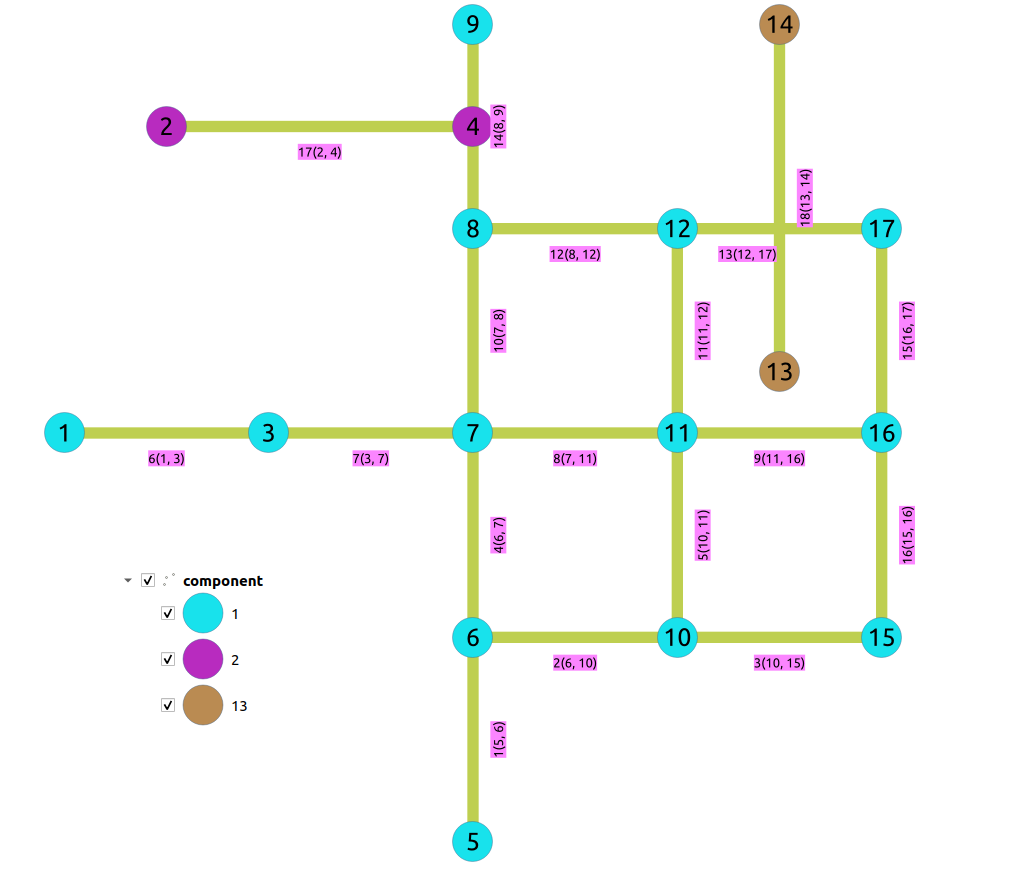Unsupported versions:2.6 2.5
pgr_connectedComponents¶
pgr_connectedComponents — 使用基于深度优先搜索(DFS)的方法计算无向图的连通分量。
可用性
版本3.0.0
结果列发生变化:
n_seq被删除seq将类型更改为BIGINT
函数正式发布。
版本2.5.0
新实验性功能。
描述¶
无向图的连通部分是指相互之间均可到达的顶点集合。
主要特点是:
适用于 无向 图。
连通分量由顶点描述
返回值是有序的:
component升序node升序
运行时间:
签名¶
(seq, component, node)- 示例:
图的连通分量
SELECT * FROM pgr_connectedComponents(
'SELECT id, source, target, cost, reverse_cost FROM edges'
);
seq | component | node
-----+-----------+------
1 | 1 | 1
2 | 1 | 3
3 | 1 | 5
4 | 1 | 6
5 | 1 | 7
6 | 1 | 8
7 | 1 | 9
8 | 1 | 10
9 | 1 | 11
10 | 1 | 12
11 | 1 | 15
12 | 1 | 16
13 | 1 | 17
14 | 2 | 2
15 | 2 | 4
16 | 13 | 13
17 | 13 | 14
(17 rows)

参数¶
参数 |
类型 |
描述 |
|---|---|---|
|
Edges SQL 如下所述。 |
内部查询¶
Edges SQL¶
列 |
类型 |
默认 |
描述 |
|---|---|---|---|
|
ANY-INTEGER |
边的标识符。 |
|
|
ANY-INTEGER |
边的第一个端点顶点的标识符。 |
|
|
ANY-INTEGER |
边的第二个端点顶点的标识符。 |
|
|
ANY-NUMERICAL |
edge ( |
|
|
ANY-NUMERICAL |
-1 |
边(
|
其中:
- ANY-INTEGER:
SMALLINT,INTEGER,BIGINT- ANY-NUMERICAL:
SMALLINT,INTEGER,BIGINT,REAL,FLOAT
结果列¶
返回集合 (seq, component, node)
列 |
类型 |
描述 |
|---|---|---|
|
|
从 1 开始的顺序值。 |
|
|
分量标识符。
|
|
|
属于该 |
其他示例¶
连接不连通的组件¶
要获取图的连通性:
SELECT * FROM pgr_connectedComponents(
'SELECT id, source, target, cost, reverse_cost FROM edges'
);
seq | component | node
-----+-----------+------
1 | 1 | 1
2 | 1 | 3
3 | 1 | 5
4 | 1 | 6
5 | 1 | 7
6 | 1 | 8
7 | 1 | 9
8 | 1 | 10
9 | 1 | 11
10 | 1 | 12
11 | 1 | 15
12 | 1 | 16
13 | 1 | 17
14 | 2 | 2
15 | 2 | 4
16 | 13 | 13
17 | 13 | 14
(17 rows)
连接组件有三种基本方法:
从顶点到边的起点
从顶点到边的终点
从边上的顶点到最近的顶点
该解决方案需要将边缘分割。
在这个例子中,将使用 pgr_separateCrossing 和 pgr_separateTouching 。
获取连接性
SELECT * FROM pgr_connectedComponents(
'SELECT id, source, target, cost, reverse_cost FROM edges'
);
seq | component | node
-----+-----------+------
1 | 1 | 1
2 | 1 | 3
3 | 1 | 5
4 | 1 | 6
5 | 1 | 7
6 | 1 | 8
7 | 1 | 9
8 | 1 | 10
9 | 1 | 11
10 | 1 | 12
11 | 1 | 15
12 | 1 | 16
13 | 1 | 17
14 | 2 | 2
15 | 2 | 4
16 | 13 | 13
17 | 13 | 14
(17 rows)
准备数据表
在本例中:边表需要增加一列,顶点表将完全重建。
ALTER TABLE edges ADD old_id BIGINT;
ALTER TABLE
DROP TABLE vertices;
DROP TABLE
插入新边线
使用 pgr_separateCrossing 和 pgr_separateTouching 将结果插入边缘表。
INSERT INTO edges (old_id, geom)
SELECT id, geom FROM pgr_separateCrossing('SELECT * FROM edges')
UNION
SELECT id, geom FROM pgr_separateTouching('SELECT * FROM edges');
INSERT 0 6
创建顶点表
使用 pgr_extractVertices 创建该表。
CREATE TABLE vertices AS
SELECT * FROM pgr_extractVertices('SELECT id, geom FROM edges');
SELECT 18
更新拓扑结构
/* -- set the source information */
UPDATE edges AS e
SET source = v.id, x1 = x, y1 = y
FROM vertices AS v
WHERE ST_StartPoint(e.geom) = v.geom;
UPDATE 24
/* -- set the target information */
UPDATE edges AS e
SET target = v.id, x2 = x, y2 = y
FROM vertices AS v
WHERE ST_EndPoint(e.geom) = v.geom;
UPDATE 24
更新其他数值
在此示例中,仅更新了 cost 和 reverse_cost 列,其值基于几何长度并通过 sign 函数保持方向性。
UPDATE edges e
SET cost = ST_length(e.geom)*sign(e1.cost),
reverse_cost = ST_length(e.geom)*sign(e1.reverse_cost)
FROM edges e1
WHERE e.cost IS NULL AND e1.id = e.old_id;
UPDATE 6
SELECT * FROM pgr_connectedComponents(
'SELECT id, source, target, cost, reverse_cost FROM edges'
);
seq | component | node
-----+-----------+------
1 | 1 | 1
2 | 1 | 2
3 | 1 | 3
4 | 1 | 4
5 | 1 | 5
6 | 1 | 6
7 | 1 | 7
8 | 1 | 8
9 | 1 | 9
10 | 1 | 10
11 | 1 | 11
12 | 1 | 12
13 | 1 | 13
14 | 1 | 14
15 | 1 | 15
16 | 1 | 16
17 | 1 | 17
18 | 1 | 18
(18 rows)
另请参阅¶
维基百科: 连通分量
索引和表格
